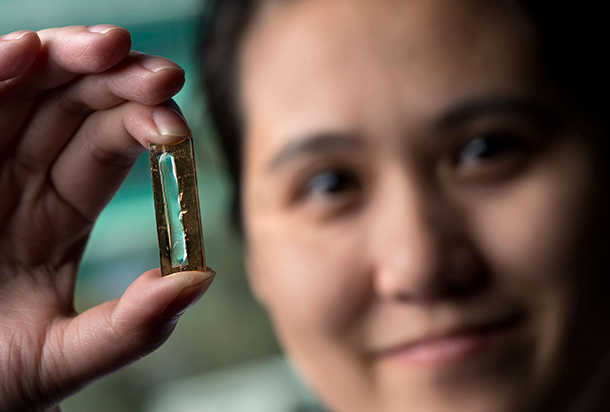Science Note: Nanowire Battery Breakthrough
Air Date: Week of November 4, 2016

UC Irvine doctoral candidate Mya Le Thai displays her experimental nanowire technology that could dramatically increase the lifespan of rechargeable lithium-ion batteries. (Photo: Steve Zylius, University of California Irvine)
Even the best batteries can only be recharged so many times, but scientists have created a new nanowire based system that increases lifespan dramatically. As Alexander Metzger reports in today’s Note on Emerging Science, the key to this game-changing battery is a special coating.
Transcript
CURWOOD: In a minute, designer-friendly solar energy roof tiles, but first this note on emerging science from Alexander Metzger.
[SCIENCE NOTE THEME]
METZGER: From cell phones to laptops to cars, batteries power many of our everyday conveniences. As these devices become increasingly important, so does the lifespan of the batteries powering them. The popular lithium-ion battery, for example, survives only a few thousand charges at most. So researchers at the University of California, Irvine have developed a technology using nanowires that could increases battery life hundreds of times.
Because Nanowires are about a thousand times thinner than a human hair, bundling them together creates a huge surface area in a tiny volume. This translates to a greater capacity to store and conduct electricity than conventional wires. But there’s a snag: Nanowires quickly degrade when electricity passes through them, a problem that scientists have been working on for decades.
This breakthrough involves using gold nanowires coated in a manganese dioxide shell, and totally encased in an electrolyte gel. This makes wires flexible and resistant to cracking and enables hundreds of thousands of charging cycles with almost no damage to the wires themselves. While gold nanowires could become expensive if used in bulk, the researchers suggest that the same technique could work with cheaper, more common metals.
Scientists believe this technology could revolutionize how we power everything, from smart phones to spacecraft. While it may be many years before these next-generation batteries are on the market, this microscopic breakthrough has the potential to bring about some very big changes.
That’s this week’s note on emerging science, I’m Alexander Metzger.
[SCIENCE NOTE THEME]
Links
University of California Irvine News: “All Powered Up”
Los Angeles Times: “UCI researchers’ invention could lead to longer-lasting batteries”
Living on Earth wants to hear from you!
Living on Earth
62 Calef Highway, Suite 212
Lee, NH 03861
Telephone: 617-287-4121
E-mail: comments@loe.org
Newsletter [Click here]
Donate to Living on Earth!
Living on Earth is an independent media program and relies entirely on contributions from listeners and institutions supporting public service. Please donate now to preserve an independent environmental voice.
NewsletterLiving on Earth offers a weekly delivery of the show's rundown to your mailbox. Sign up for our newsletter today!
 Sailors For The Sea: Be the change you want to sea.
Sailors For The Sea: Be the change you want to sea.
 The Grantham Foundation for the Protection of the Environment: Committed to protecting and improving the health of the global environment.
The Grantham Foundation for the Protection of the Environment: Committed to protecting and improving the health of the global environment.
 Contribute to Living on Earth and receive, as our gift to you, an archival print of one of Mark Seth Lender's extraordinary wildlife photographs. Follow the link to see Mark's current collection of photographs.
Contribute to Living on Earth and receive, as our gift to you, an archival print of one of Mark Seth Lender's extraordinary wildlife photographs. Follow the link to see Mark's current collection of photographs.
 Buy a signed copy of Mark Seth Lender's book Smeagull the Seagull & support Living on Earth
Buy a signed copy of Mark Seth Lender's book Smeagull the Seagull & support Living on Earth

